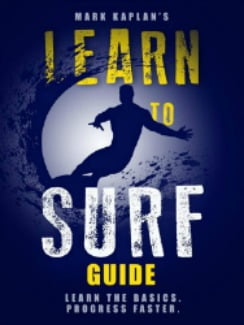Surfers Learn Pop Up Timing
Surfers learn pop up timing that is important for catching foam or real waves. Most beginners without instructions have no idea of the steps nor the timing necessary to catch waves and pop up for riding.
Learn the Timing and Rhythm
I give new students a count that helps set the rhythm. First they have to paddle until they catch the wave. Most new people have difficulty with the patience necessary to paddle more after the wave hits the surfboard. In foam waves, it takes about three more paddles to get in front of the wave. In real waves it is usually three paddles start down the face.
Once the surfboard is in front of the wave or going down the face of the wave, the surfer puts his hands in a man’s push up position and rests for a second. Most beginners go into a push up extended position immediately and launch off the front of the board. Its the number two mistake new people make. Surfers learn the pop up timing from practice and coaching.
The third step is pushing up into a full extension and for new people, putting their back foot flat on the board under their butt. The idea is to place the foot flat so the surfer can stand up on it. Most advanced surfers riding real waves will pop both feet onto the board.
Learning When to Stand Up
In the fourth step, the new surfer stands on the back foot raising his hands and torso while moving the other foot to the front of the board. When the front foot arrives, the surfers torso needs to be upright and the hands in the air. Most beginners are still holding onto the board when their front foot is placed. This causes them to fly off the front of the board from being in yoga’s down dog position.
The Right Posture on the Surf Board
When the new surfer arrives in the standing position their posture on the board has to be correct. The front foot has to be in the middle of the board about two feet from the nose. The back foot is still in the back about two to three feet from the front foot to get a good stance. The hips and shoulders have to be squared to the front. Weight is equal on front and back leg, and the the knees are flexed. The timing is important. No need to rush. It is important to get each step of the sequence.
Learn More
For Oceanside Surf Lessons, see the Home Page
See the Post What You Learn in a 2 Hour Lesson
See the Post How to Progress in Surfing
See My Dry Land and In Water Demo video
See How to Catch a Green/Real Wave video
My New Surfing Course in an E-Book plus Demo Video
Get the 18 Chapter, 7,500 word Course that can prepare you for a lesson or give you the fundamentals if you are going to try it on your own. 10 years of teaching 350 students a year has given me the insights on the most precise measures you must follow for success. This course is what I teach on the dry land and in water instruction. The Course includes a 15 minute video on my dry land and in water demonstration. Only $4.95
Buy the E-book for $4.95. Learn to Surf (Different cover but same book)
Buy the Paperback on Amazon $7.95
